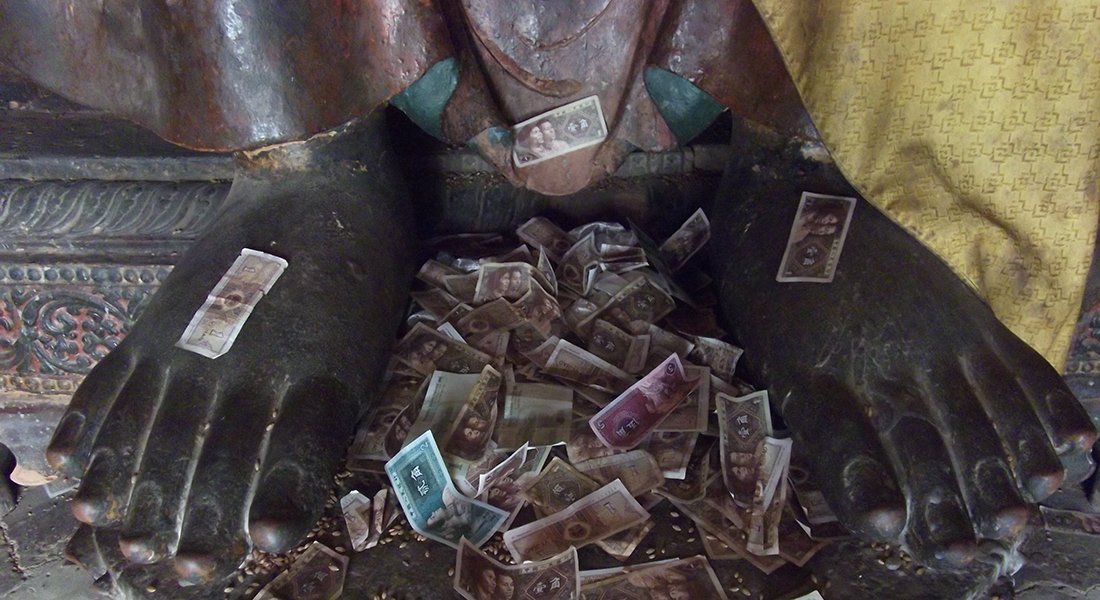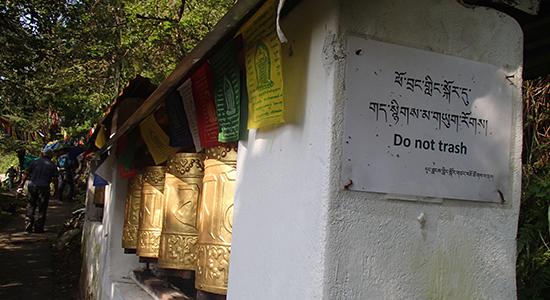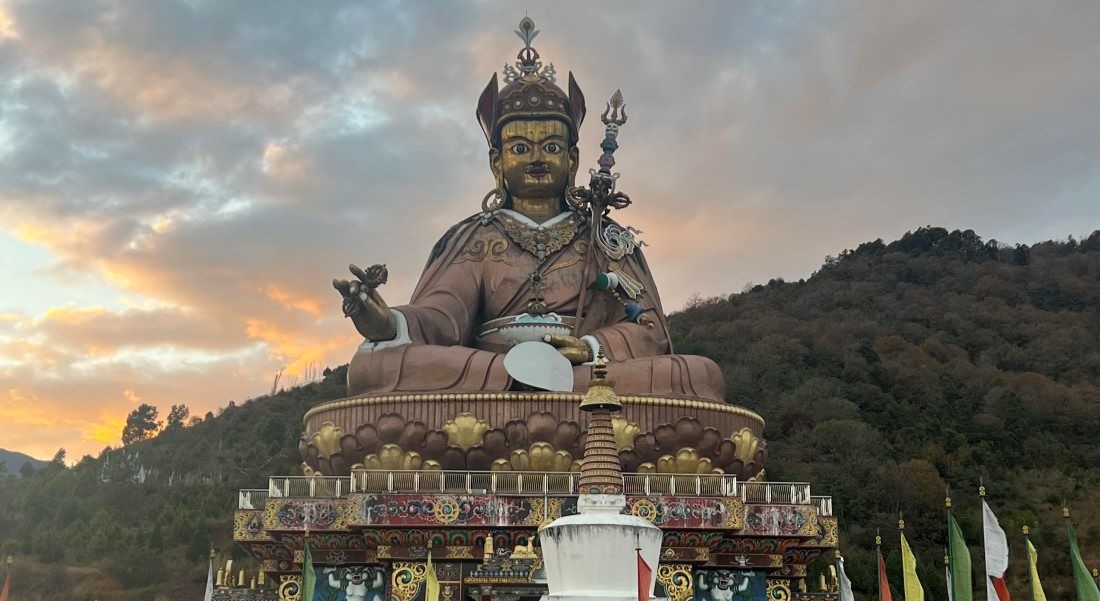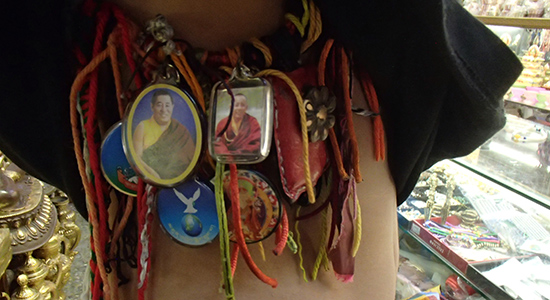Research focus areas
CCBS is a unique international center of excellence for contemporary Buddhist studies, which is otherwise lacking worldwide. The research centre provides a supportive environment in which scholars, students, and others can immerse themselves in the questions generated by our four strategic research areas:
- Buddhism and economy
- Buddhism and waste
- Buddhism and infrastructure
- Materials and materiality in Buddhism
Buddhism and economy
Headed by Trine Brox.
Buddhism and economy broadly encompasses the instrumentalisation of global Buddhism and the imbrication of spirituality and materialism. It draws from anthropological data on lived religion to elucidate how Buddhism can create symbolic capital, material value, soft power and discursive effects in various ethnographic contexts throughout the world.

Whilst Buddhism is often seen in popular culture as being untethered from, and even anathema to, economic considerations, recent scholarship demonstrates that wealth accumulation is a central part of Buddhism. Indeed, studies now recognise that rather than having a negative attitude toward wealth, financial acquisitiveness is frequently considered to be ideologically compatible with Buddhist principles about karmic reward or the propagation of the dharma.
Research at The Center for Contemporary Buddhist Studies looks at how Buddhism institutions and religious specialists are embedded in broader economic realites.
Buddhism and waste
Headed by Paulina Kolata.
The CCBS’ strategic research focus WASTE studies Buddhism from an unusual angle, namely from the perspective of destruction, breakdown, and death. We are interested in how the things that constitute Buddhism dematerialise and how they are imagined and handled.

The strategic research focus WASTE highlights a generally ignored but important aspect of object biographies that can help us understand the productive, social dimensions of religious materiality and lived religion. We are interested in how waste is produced or ends up in the religious field, what happens to it when it is proximate to sacred landscapes, people, objects, and messages, and when it consists of the remnants of rituals or is an object of faith and devotion. As stated in our first edited volume on this topic: “.. waste is diverse, ambiguous, and burdensome, but it is also productive.
Approaching its study through the categories of excess, discard, and afterlife offers a conceptualization of waste that can encompass the variety of post-consumption fates that await stuff that is used, abandoned, worn and consumed by people in Buddhist places or through Buddhist practices.” (page 21 in Brox and Williams-Oerberg (2022) Buddhism and Waste: The Excess, Discard, and Afterlife of Buddhist Consumption. Bloomsbury Academic, pp. 1-30.)
Buddhism and infrastructure
Headed by Dendup Chophel.
Tremendous urban infrastructure aspirations and needs face Asia, the most populous continent. Yet it is incapacitated by conflicting geostrategic imperatives of its major countries, inadequate investment prospects, and an ongoing climate crisis.

As various Buddhist organizations (temples, charity groups, NGOs) have begun to actively engage with social and global issues like poverty and environmental crisis, Buddhism is emerging as a socio-political force capable of facilitating common actions in building more equitable and sustainable infrastructure for shared prosperity in Asia and beyond. Buddhism is nowadays constructed as a dynamic force capable of bringing into conversation diverse traditions from different religions and cultures across Asia.
Buddhism shares porous spiritual boundaries with Hinduism, Confucianism, Taoism, Shintoism, Tengrism and Bonism, which creates bilateral and multilateral spaces for engagement. As its influence as a major socio-economic force grows, Buddhism’s relationship with societies, economies, states, and global politics is changing. As infrastructure projects including physical and digital connectivity build bonds within and outside Asia, these infrastructures have also intensified circulation of Buddhism and other religions, which is central to the cultural and national identity of many countries in the region.
Building on its strength as a leading center for the study of contemporary Buddhist economic and infrastructure building practices, CCBS seeks to address these changes in how Buddhism is playing a role in providing platforms and resources for matters that were once largely considered secular, economic and/or political.
By focusing on this “new” role of Buddhism at the national and global levels, we ask how Buddhism, and religion more broadly, serve as forms of infrastructure and “soft power” in national and transnational contexts. We examine whether or how Buddhism operates as a physical or virtual network, or as a platform for facilitating and (dis)connecting movements, ideas, people, and technologies. We are interested in studying how Buddhism challenges, confirms, or transforms state governance and global relationships within and beyond Asian countries.
By exploring these diverse facets of contemporary Buddhism, we ultimately seek to ask whether Buddhism can provide a unified framework for collective actions to address critical societal needs like sustainable infrastructure development or whether it will end up becoming one more source of division and waste in an already polarized and degenerated world.
Materials and materiality in Buddhism
Headed by Trine Brox.
Buddhism is often portrayed as anti-materialist, yet material things contribute in important ways to defining Buddhist places, communities, bodies and practices. The research field of things, the materials that they are made of, and their materiality are part of several research projects at the CCBS.

The research trajectory in the field of material religion has often been the ways in which material objects mediate the sacred. While inspired by this rich research field, at the Center for Contemporary Buddhist Studies, we are interested more broadly in the things that are found and used within Buddhism, not only as mediators, representations and symbols, but also as efficacious technology, objects of worship, and as religious goods that are produced and consumed.
Moreover, we want to understand both the socially constructed materiality of these things without neglecting the materials that constitute them. How does materials affect the ways in which they are experienced through the senses and utilised? How do they enact their own material properties? And what are their life trajectories, in and beyond their usage?
